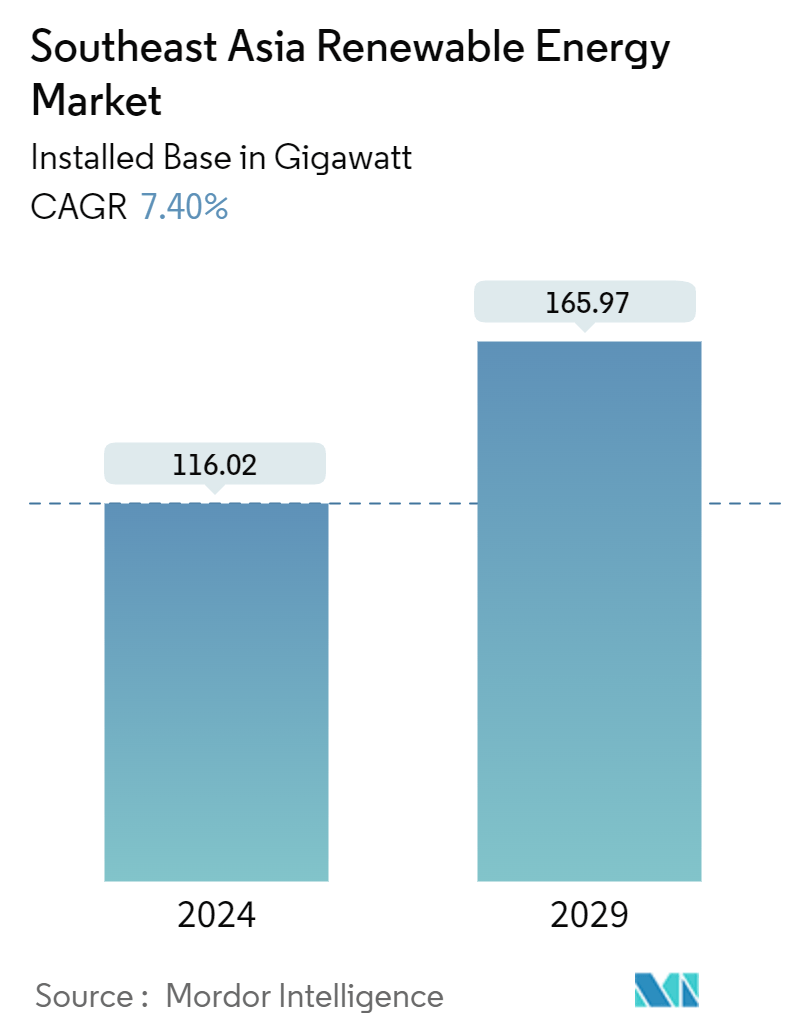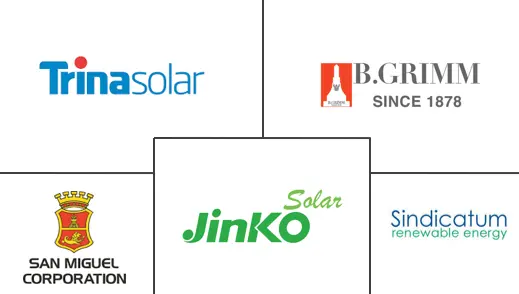Market Size of Southeast Asia Renewable Energy Industry

| Study Period | 2024 - 2029 |
| Base Year For Estimation | 2023 |
| Market Volume (2024) | 116.02 gigawatt |
| Market Volume (2029) | 165.97 gigawatt |
| CAGR (2024 - 2029) | 7.40 % |
| Market Concentration | Low |
Major Players
*Disclaimer: Major Players sorted in no particular order |
Southeast Asia Renewable Energy Market Analysis
The Southeast Asia Renewable Energy Market size in terms of installed base is expected to grow from 116.02 gigawatt in 2024 to 165.97 gigawatt by 2029, at a CAGR of 7.40% during the forecast period (2024-2029).
- Coal-fired power generation is the dominant form of power generation in Southeast Asia. However, renewable power generation and battery costs registered a significant decline in recent years, combined with the drying up of the finances for coal-fired power plants. This is expected to drive the renewable energy sector in Southeast Asia during the forecast period.
- However, the lack of international companies' investments and the delay in the practical deployment of projects are expected to hinder the market's growth.
- The Southeast Asian region has insufficient indigenous fossil fuel resources to meet its growing energy demand, thus creating significant opportunities for renewable energy installations, which can then solve the region's ever-increasing energy demand.
- Vietnam has a high potential for renewable energy, thus creating its dominance in the region's renewable energy market during the forecast period.
Southeast Asia Renewable Energy Industry Overview
Renewable energy is the energy produced from sources such as the sun and wind that are abundant and do not run out. Renewable energy is commonly used for electricity generation, space and water heating and cooling, and transportation. Biomass, geothermal resources, sunlight, water, and wind are some of the energy sources that can be converted into clean and usable energy.
The Southeast Asian renewable energy market is segmented by type and geography. By type, the market is segmented into solar, wind, hydro, bioenergy, and other types. By geography, the market is segmented into Vietnam, Malaysia, Thailand, the Philippines, Indonesia, and Rest of Southeast Asia. The report also covers the market size and forecasts for the renewable energy market across the major countries in the region. For each segment, market sizing and forecasts were made based on installed capacity (GW).
| By Type | |
| Solar | |
| Wind | |
| Hydro | |
| Bioenergy | |
| Other Types |
| By Geography | |
| Vietnam | |
| Indonesia | |
| Philippines | |
| Thailand | |
| Malaysia | |
| Rest of Southeast Asia |
Southeast Asia Renewable Energy Market Size Summary
The Southeast Asia renewable energy market is poised for significant expansion, driven by a shift from coal-fired power generation to renewable sources due to declining costs and financial constraints on coal projects. The region's limited fossil fuel resources and increasing energy demand present substantial opportunities for renewable energy installations. Vietnam stands out as a key player, leveraging its high potential in renewable energy, particularly solar and wind, to dominate the market. The country's government has set ambitious targets for solar and wind power capacity, supported by favorable policies and foreign investments, which are expected to propel the growth of the renewable energy sector.
Southeast Asia is emerging as a rapidly growing solar energy market, with Vietnam and Thailand leading in new photovoltaic capacity installations. The region benefits from abundant solar resources, increasing electricity demand, and supportive renewable energy policies. Efforts to secure a sustainable energy future are underway, with countries like the Philippines planning significant solar power projects. The development of floating solar photovoltaic plants is also anticipated, further enhancing the region's renewable energy mix. Despite challenges such as limited international investment and project deployment delays, the market is expected to witness substantial growth, with Vietnam playing a pivotal role in the region's renewable energy landscape.
Southeast Asia Renewable Energy Market Size - Table of Contents
-
1. MARKET OVERVIEW
-
1.1 Introduction
-
1.2 Southeast Asia Renewable Energy Mix, 2023
-
1.3 Renewable Energy Installed Capacity and Forecast in GW, till 2029
-
1.4 Recent Trends and Developments
-
1.5 Government Policies, Targets, and Regulations
-
1.6 Market Dynamics
-
1.6.1 Drivers
-
1.6.1.1 Increasing Investments in Renewable Energy Generation
-
1.6.1.2 Favorable Government Policies
-
-
1.6.2 Restraints
-
1.6.2.1 Initial Cost of Renewable Energy Is High
-
-
-
1.7 Supply Chain Analysis
-
1.8 Industry Attractiveness - Porter's Five Forces Analysis
-
1.8.1 Bargaining Power of Suppliers
-
1.8.2 Bargaining Power of Consumers
-
1.8.3 Threat of New Entrants
-
1.8.4 Threat of Substitute Products and Services
-
1.8.5 Intensity of Competitive Rivalry
-
-
-
2. MARKET SEGMENTATION
-
2.1 By Type
-
2.1.1 Solar
-
2.1.2 Wind
-
2.1.3 Hydro
-
2.1.4 Bioenergy
-
2.1.5 Other Types
-
-
2.2 By Geography
-
2.2.1 Vietnam
-
2.2.2 Indonesia
-
2.2.3 Philippines
-
2.2.4 Thailand
-
2.2.5 Malaysia
-
2.2.6 Rest of Southeast Asia
-
-
Southeast Asia Renewable Energy Market Size FAQs
How big is the Southeast Asia Renewable Energy Market?
The Southeast Asia Renewable Energy Market size is expected to reach 116.02 gigawatt in 2024 and grow at a CAGR of 7.40% to reach 165.97 gigawatt by 2029.
What is the current Southeast Asia Renewable Energy Market size?
In 2024, the Southeast Asia Renewable Energy Market size is expected to reach 116.02 gigawatt.

